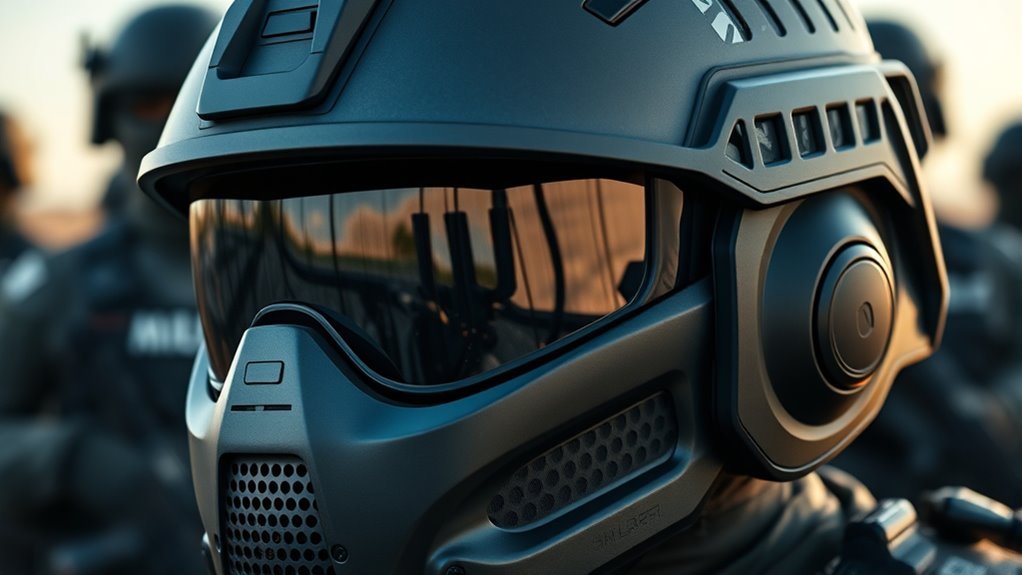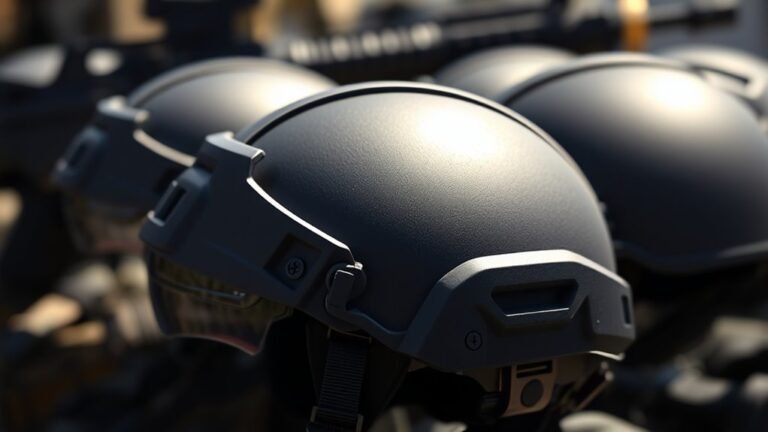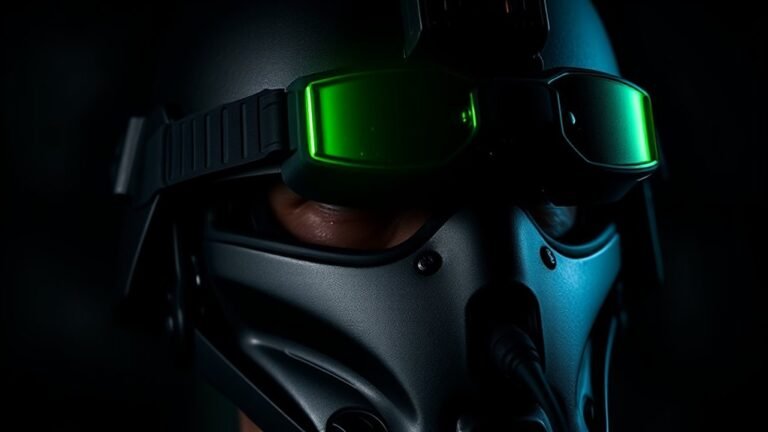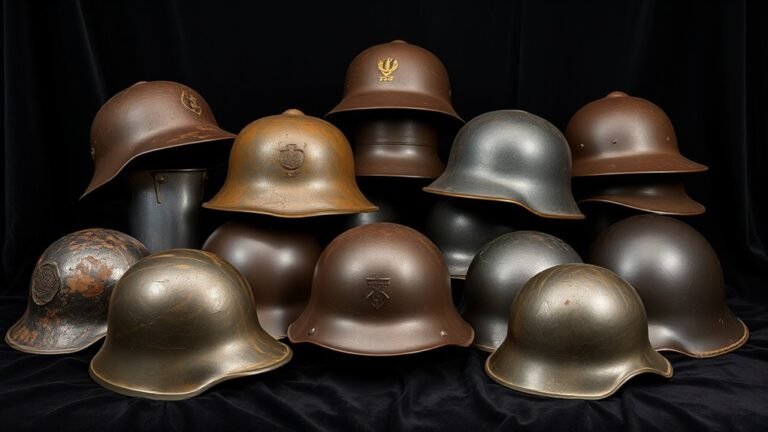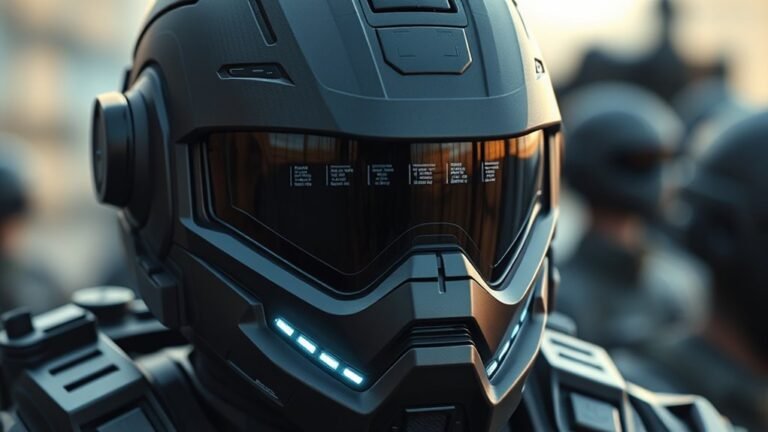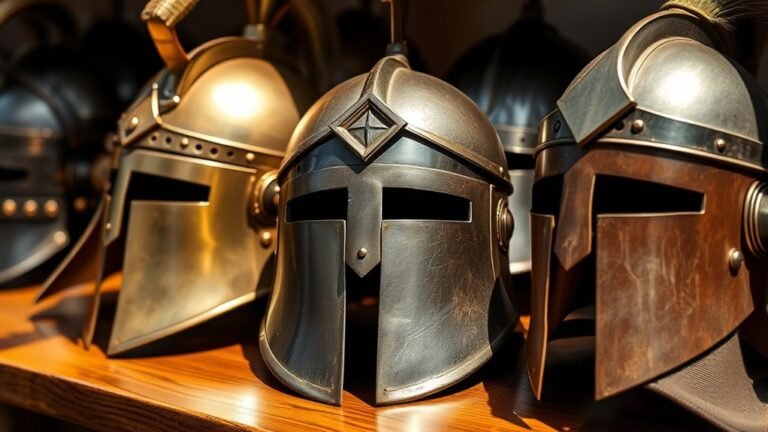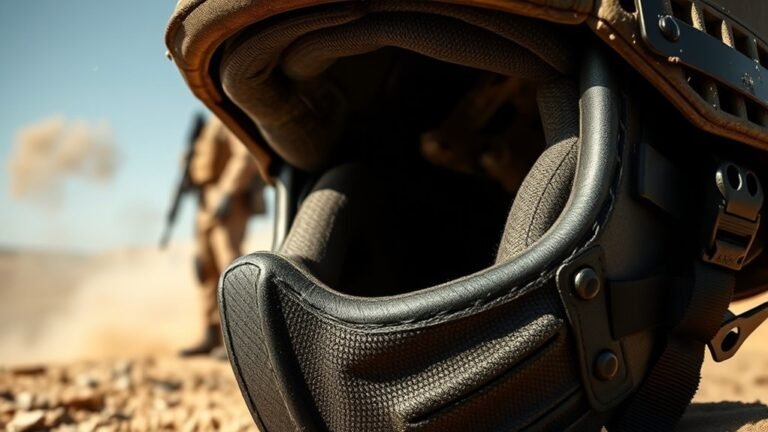Military Helmets: Technology and Protection Advances
Military helmets have advanced dramatically, integrating light, durable materials like Kevlar and carbon fibers for superior protection. These innovations enhance ballistic resistance while guaranteeing comfort and mobility. Integrated communication systems improve situational awareness, and augmented reality provides essential tactical information. Rigorous testing confirms helmets can absorb impacts and mitigate concussive injuries. Future trends point towards custom-fitted designs and advanced technology, transforming personal defense for soldiers. To understand how these advancements shape operational effectiveness, keep exploring further.
Evolution of Military Helmet Design
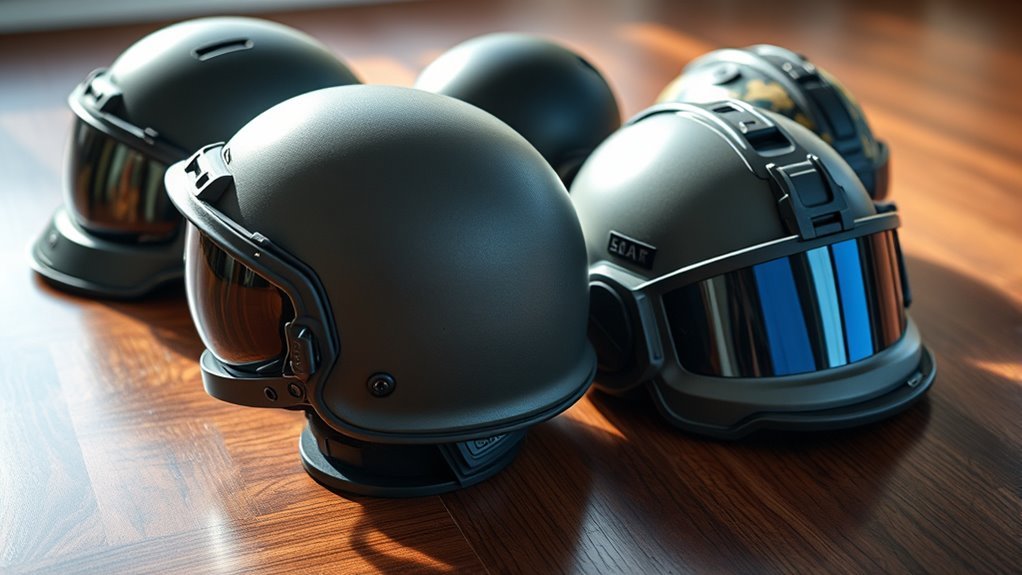
As military conflicts evolved over centuries, so did the design and functionality of helmets, reflecting the changing nature of warfare and technology. Early historical designs, such as the Roman galea, were crafted from bronze and leather, offering basic protection. As combat tactics shifted, so did helmet materials; by the Middle Ages, steel became prevalent, providing greater durability against piercing weapons. The introduction of articulated designs improved mobility while maintaining protection. In the 20th century, advancements in metallurgy and manufacturing techniques led to lighter, more resilient helmets. Today, military helmets incorporate composite materials, enhancing both safety and comfort. This evolution showcases a continuous pursuit of innovative solutions to safeguard freedom fighters, adapting to the demands of increasingly complex battlefields.
Advanced Materials for Enhanced Protection
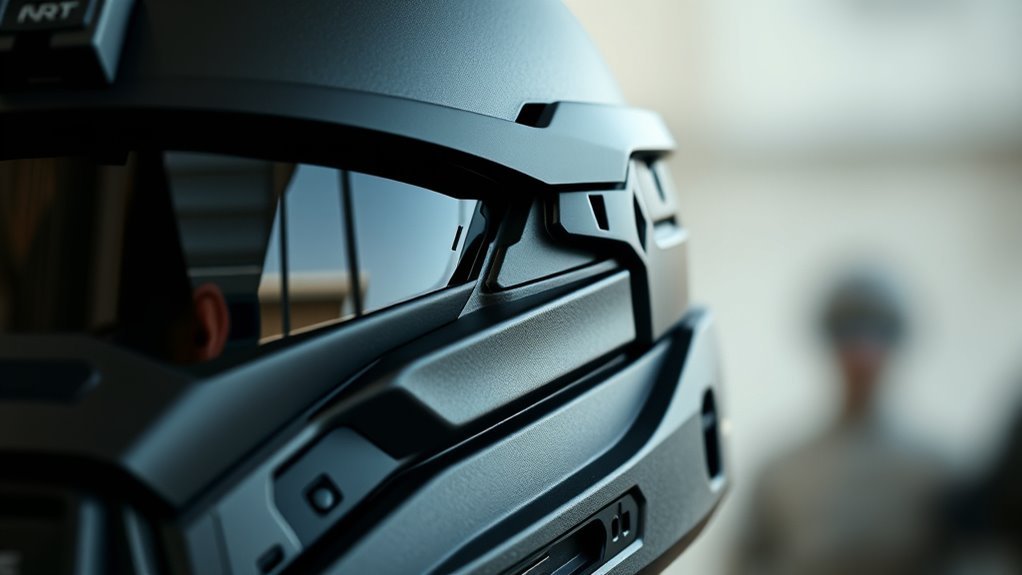
The evolution of military helmets has paved the way for innovative materials that greatly enhance protective capabilities. You’ll find that modern helmets utilize advanced composite materials, which considerably improve their ballistic properties. These materials, often a blend of Kevlar, carbon fibers, and other polymers, offer superior strength while remaining lightweight. This balance is vital for soldiers who need mobility without compromising safety. The use of these composites allows for thinner designs that still meet stringent military standards, absorbing and dispersing impact energy effectively. In addition, advancements in manufacturing processes, such as 3D printing, enable the production of custom-fitted helmets, enhancing comfort and protection. Overall, these developments reflect a commitment to ensuring the safety of personnel in increasingly hostile environments.
Integration of Communication Systems
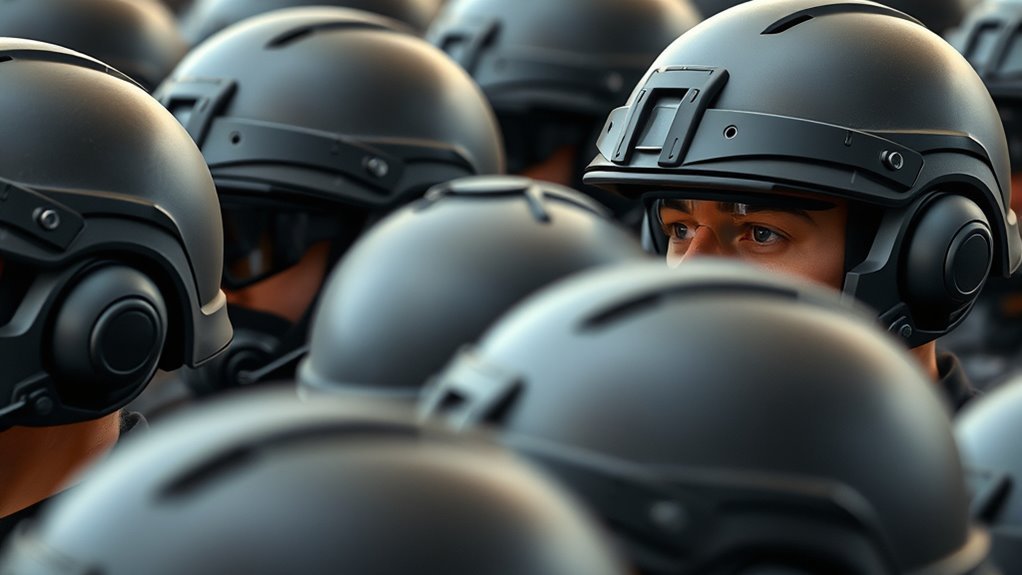
As you explore the integration of communication systems in military helmets, consider how these advancements greatly enhance situational awareness. By facilitating real-time communication, soldiers can coordinate more effectively, ensuring that critical information is shared without delay. This streamlined communication not only improves individual performance but also strengthens team dynamics in high-pressure environments.
Enhanced Situational Awareness
While traditional military helmets primarily focused on protection, recent advancements have emphasized the integration of communication systems to enhance situational awareness on the battlefield. You’ll find that these systems allow for real-time data sharing, enabling soldiers to make informed decisions swiftly. However, it’s vital to balance this enhanced communication with cognitive load management to prevent sensory overload. Overloading a soldier with information can hinder their response time and decision-making capabilities. Sophisticated auditory and visual interfaces help filter essential data, ensuring you receive only the most important updates. This strategic integration not only boosts your situational awareness but also reinforces safety, allowing you to navigate complex environments with greater confidence. Embracing this technology is key to modern warfare effectiveness.
Streamlined Team Coordination
Effective team coordination is essential for mission success, especially in dynamic combat scenarios where split-second decisions can determine outcomes. Integrating advanced communication systems into military helmets greatly enhances team dynamics, allowing seamless sharing of critical information. This integration improves operational efficiency by enabling real-time updates on enemy positions, troop movements, and tactical adjustments. With voice-activated controls and noise-canceling technology, you can communicate effectively even in chaotic environments. Furthermore, situational awareness is amplified as each team member receives instant feedback, fostering a cohesive unit that functions with precision. Ultimately, these innovations not only bolster individual safety but also empower you to act decisively, enhancing the overall effectiveness of your mission and preserving the freedom you endeavor to protect.
Impact Resistance and Concussive Protection
When considering the protection offered by military helmets, understanding impact resistance and concussive protection is essential for ensuring soldier safety in combat situations. Modern helmets undergo rigorous ballistic testing to assess their ability to withstand high-velocity impacts while maintaining structural integrity. These tests simulate various combat scenarios, revealing how well a helmet can absorb shock and dissipate energy. Effective concussion mitigation is vital, as even non-penetrating impacts can cause traumatic brain injuries. Advanced materials, such as aramid fibers and expanded polystyrene, enhance energy absorption capabilities, reducing the risk of concussions. By focusing on these critical aspects, military helmets are designed to provide thorough protection, empowering soldiers to engage confidently in their missions while minimizing the risk of life-altering injuries.
Lightweight Solutions for Increased Mobility
As military operations evolve, the demand for lightweight solutions in helmet design becomes increasingly essential for enhancing soldier mobility. Utilizing advanced lightweight materials, manufacturers are now able to create helmets that provide robust protection without compromising agility. For instance, aramid fibers and composite resins offer exceptional strength-to-weight ratios, greatly reducing the overall burden on soldiers during missions. This mobility enhancement allows for quicker maneuvers and improved endurance, which are critical in dynamic combat environments. Additionally, the integration of these lightweight materials facilitates better ventilation and comfort, enabling soldiers to maintain focus and efficiency. As we advance, the shift toward lightweight helmet solutions represents a pivotal step in optimizing performance while ensuring that soldiers remain protected on the battlefield.
Modular Helmet Systems
Given the diverse and unpredictable nature of modern combat situations, modular helmet systems have emerged as a crucial innovation in military headgear design. These systems allow for modular attachments, enabling you to customize your helmet according to specific mission requirements. You can easily adapt your gear for varying environments, whether it’s incorporating communication devices, night vision mounts, or ballistic face shields. This flexibility not only enhances your operational efficiency but also improves personal safety. With helmet customization, you’re no longer limited to a one-size-fits-all approach; instead, you can tailor your protective gear to meet the demands of each unique scenario. Such advancements reflect a commitment to maximizing protection while empowering you to maintain freedom of movement in the field.
Smart Technology and Augmented Reality
Smart technology and augmented reality are revolutionizing military helmets by considerably enhancing situational awareness through real-time data overlays. With integrated communication systems, these advancements allow for seamless interaction among team members, reducing response times during critical operations. This integration not only improves tactical decision-making but also guarantees that soldiers remain connected and informed in dynamic environments.
Enhanced Situational Awareness
While traditional helmets primarily focus on protection, the integration of smart technology and augmented reality is revolutionizing enhanced situational awareness for military personnel. These advancements provide cognitive enhancements that enable you to process information more efficiently in high-stress environments. By incorporating sensory integration, your helmet can deliver real-time data overlays, mapping enemy positions or identifying potential threats without diverting your attention. This technology allows you to maintain a thorough awareness of your surroundings, enhancing decision-making capabilities. Additionally, augmented reality can simulate various scenarios, improving your training and readiness. Ultimately, these innovations not only improve your safety but also empower you with the freedom to act decisively, ensuring you’re always one step ahead on the battlefield.
Integrated Communication Systems
Integrated communication systems in military helmets are transforming how personnel interact and share information on the battlefield. With advancements in smart technology and augmented reality, these systems provide seamless integration of critical features:
- Wireless connectivity allows real-time communication without cumbersome wires.
- Audio clarity guarantees that every command and report is crystal clear, even in chaotic environments.
- Augmented reality displays overlay essential tactical information directly into the user’s field of vision.
- Data sharing capabilities enable quick dissemination of intelligence among team members, enhancing collaborative decision-making.
These innovations not only improve operational efficiency but also empower soldiers with the freedom to act decisively, fostering a more dynamic and responsive combat environment. The future of military engagements hinges on these technologies.
Testing and Evaluation Standards
As military helmet technology evolves, rigorous testing and evaluation standards become essential to guarantee peak performance and safety for personnel. These standards are vital for evaluating helmet safety against various threats, including ballistic impacts and blunt force trauma. Utilizing performance metrics, each helmet undergoes a series of tests that simulate real-world conditions, ensuring they meet or exceed established benchmarks. Testing protocols often include drop tests, penetration evaluations, and environmental exposure assessments. By adhering to these stringent guidelines, manufacturers can provide helmets that not only protect but also enhance operational effectiveness. As you consider helmet options, understanding these testing and evaluation standards will empower you to make informed choices that prioritize safety and performance in high-stakes environments.
Future Trends in Military Helmet Technology
With advancements in materials science and engineering, the future of military helmet technology is set to redefine personal protection for soldiers. You can expect future innovations that focus on:
- Lightweight materials that enhance mobility without sacrificing protection.
- Smart technology integration, including sensors for real-time data on the soldier’s environment.
- Enhanced helmet customization, allowing for adjustable fit and modular attachments tailored to specific missions.
- Advanced ballistic protection, ensuring better resilience against emerging threats.
These developments not only prioritize safety but also empower soldiers with the freedom to adapt their gear according to diverse operational demands. As helmet technology evolves, it’ll transform how you approach personal defense, enhancing your effectiveness in the field while maintaining comfort and mobility.
Frequently Asked Questions
How Often Are Military Helmets Replaced in Active Service?
Military helmets typically have a lifespan of about five to ten years, depending on usage and environmental conditions. Replacement frequency can vary based on the intensity of operations and exposure to impacts. It’s essential to assess the helmet’s condition regularly, as wear and tear can compromise safety. By ensuring timely replacements, you maintain best protection for personnel, ultimately preserving their freedom to operate effectively in diverse situations. Always prioritize safety through regular evaluations.
What Are the Costs Associated With Modern Military Helmets?
When you consider modern military helmets, think of them as the armor of a knight, reimagined for today’s battlefield. The costs associated with helmet manufacturing can vary considerably, often ranging from $300 to over $1,000 per unit, depending on materials and technology. A thorough cost analysis reveals that investing in advanced protection translates to enhanced soldier safety, reflecting both tactical value and the commitment to preserving freedom on the frontlines.
How Do Military Helmets Affect Soldiers’ Comfort Over Long Periods?
Military helmets considerably impact your comfort during extended use due to their weight and ergonomic design. A well-balanced helmet reduces strain on your neck and shoulders, allowing for more prolonged wear without fatigue. Innovations in materials have led to lighter helmets, which enhance mobility and lessen discomfort. Additionally, ergonomic features, like adjustable straps and padding, provide a better fit, ensuring you can maintain focus and effectiveness without being distracted by discomfort.
Are There Specific Care Instructions for Military Helmets?
Yes, there are specific care instructions for military helmets. You should follow established helmet maintenance guidelines, which typically include regular inspections for damage and ensuring the fit remains secure. For cleaning, stick to approved cleaning protocols—use mild soap and water, avoiding harsh chemicals that could compromise materials. Always air dry your helmet to prevent moisture damage, and store it in a cool, dry place to maintain its structural integrity. Your safety depends on proper care.
What Role Do Helmets Play in Psychological Warfare or Morale?
Helmets hold heavy symbolism, serving as a steadfast shield for soldiers’ spirits. They greatly impact morale, acting as a visible reminder of strength and unity. When you don a helmet, it’s not just protection; it’s a psychological boost, fostering feelings of courage and resilience. In the domain of psychological warfare, the sight of a helmet can intimidate opponents while reinforcing your own group’s confidence, creating a powerful perception of preparedness and determination.
